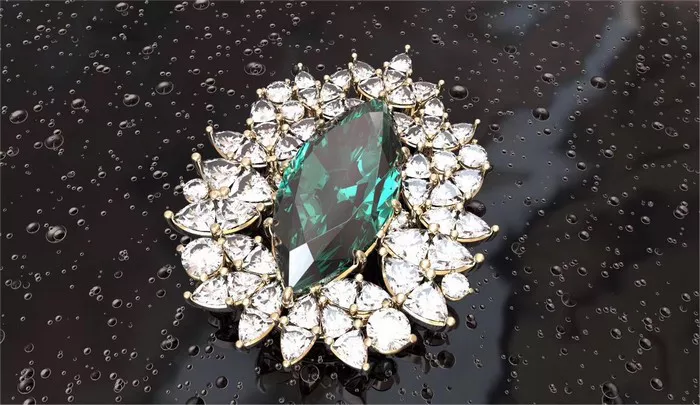Emerald, a gemstone revered for its vibrant green hue and deep cultural significance, has been prized for centuries across various civilizations. In Islamic culture, the emerald is not just a symbol of beauty but also a stone of profound spiritual importance. Its role in Islamic rituals and ceremonies is both historical and symbolic, reflecting the gemstone’s association with divine protection, wisdom, and eternal life. This article delves into the deep-rooted connection between emeralds and Islamic traditions, exploring how this gemstone has been integrated into rituals and ceremonies over time.
Historical Significance of Emerald in Islamic Culture
Emeralds in Early Islamic Civilizations
Emeralds have been valued in the Islamic world since the early days of the civilization. The earliest references to emeralds in Islamic culture can be traced back to the Abbasid Caliphate, where they were treasured for their beauty and believed to have protective powers. These gemstones were often associated with paradise, as the Quran describes heaven as a garden with lush greenery, a concept that naturally linked the vibrant green of emeralds to the idea of eternal paradise.
Symbolism of Emeralds in Islamic Texts
In Islamic tradition, the emerald is often associated with the concepts of knowledge, wisdom, and spiritual growth. This is reflected in various Islamic texts and teachings that emphasize the value of wisdom and enlightenment. The Prophet Muhammad is said to have appreciated the beauty and symbolism of emeralds, and this gemstone has been linked to the Prophet’s wisdom and his teachings about the eternal nature of the soul.
The Role of Emeralds in Islamic Rituals
Emeralds in Religious Ceremonies
Emeralds play a significant role in Islamic religious ceremonies, particularly in the context of weddings and other important life events. During weddings, emeralds are often gifted to the bride as a symbol of prosperity, protection, and eternal love. The green color of the emerald is associated with fertility and growth, making it a meaningful gift that embodies the blessings of a fruitful and harmonious marriage.
In some Islamic cultures, emeralds are also used in ceremonies that mark important life transitions, such as the birth of a child or the attainment of a significant religious milestone. The gemstone is believed to bring good fortune and divine protection, serving as a reminder of the wearer’s connection to the spiritual world.
Emeralds in Islamic Jewelry
Islamic jewelry often features emeralds, not just for their aesthetic appeal but also for their spiritual significance. Rings, pendants, and other forms of jewelry adorned with emeralds are commonly worn during religious observances and prayers. The presence of emeralds in these items is thought to enhance the spiritual experience, providing the wearer with clarity of thought and a deeper connection to the divine.
Use of Emeralds in Talismanic Practices
Emeralds have long been used in talismanic practices within Islamic culture. These gemstones are believed to possess protective properties that can shield the wearer from harm and negative energies. Talismanic emeralds are often engraved with Quranic verses or symbols, further enhancing their protective powers. These talismans are carried or worn during prayers, ceremonies, and everyday life to invoke divine protection and guidance.
See Also: How to Identify Genuine Zambian Emeralds
The Spiritual and Mystical Properties of Emeralds in Islam
Emeralds as a Symbol of Divine Wisdom
In Islamic mysticism, or Sufism, emeralds are considered a symbol of divine wisdom and insight. The gemstone’s deep green color is associated with the heart chakra, which is believed to be the center of love and compassion. Sufi practitioners often use emeralds in meditation and spiritual practices to enhance their connection with the divine and to cultivate a sense of inner peace and wisdom.
Healing Properties of Emeralds
Emeralds are also believed to have healing properties in Islamic tradition. They are thought to balance emotions, calm the mind, and promote physical and spiritual healing. This belief is rooted in the idea that emeralds can harmonize the energies of the body and mind, leading to overall well-being. The gemstone is often used in healing rituals and is believed to provide relief from various ailments, both physical and spiritual.
Emeralds in Islamic Art and Architecture
The influence of emeralds extends beyond personal adornment and into the realm of Islamic art and architecture. The rich green of emeralds is often replicated in the tiles and mosaics that adorn mosques and other religious buildings. This color choice is not merely aesthetic; it symbolizes paradise and spiritual purity, reinforcing the sanctity of these spaces. The use of emerald-like hues in Islamic architecture serves as a visual reminder of the divine and the eternal.
Conclusion
The emerald’s role in Islamic rituals and ceremonies is deeply intertwined with its symbolism of wisdom, protection, and divine connection. From its historical significance in early Islamic civilizations to its continued use in religious ceremonies, jewelry, and talismanic practices, the emerald remains a gemstone of profound spiritual importance in Islam. Its vibrant green color, associated with paradise and eternal life, makes it a powerful symbol of the divine. Whether worn as a piece of jewelry, used in a religious ceremony, or incorporated into Islamic art, the emerald continues to inspire and uplift those who seek a deeper connection with their faith.


